Table of Contents


What Is Blockchain Technology? A Beginner’s Guide 2025
Listen to the Audio :
Embracing blockchain and understanding its applications will be crucial for staying ahead in the rapidly evolving sectors. Blockchain technology is an immutable ledger, preserving the unmodifiable record of each ownership's digital asset. In that lineup, the benefits of blockchain include increased security, trust, and transparency among organizations over the past few years.
If you are wondering, “What is blockchain technology?” then here’s our blog to help you with that question. It contains every detail about blockchain, including how it works, its benefits, types, and use cases, that an outsider can easily understand.
What is Blockchain Technology?
Blockchain is an advanced and secure decentralized digital ledger system that smooths the way for recording transactions across a business network. Moreover, a blockchain is a distributed database, which is shared and used over a computer network.
Beneath this, blockchain development allows for an immutable, permanent, and transparent recording of transactions and data. As a final result, you can easily make payments and track orders, accounts, and other transactions in a secure way using blockchain technology.
How Does Blockchain Work?
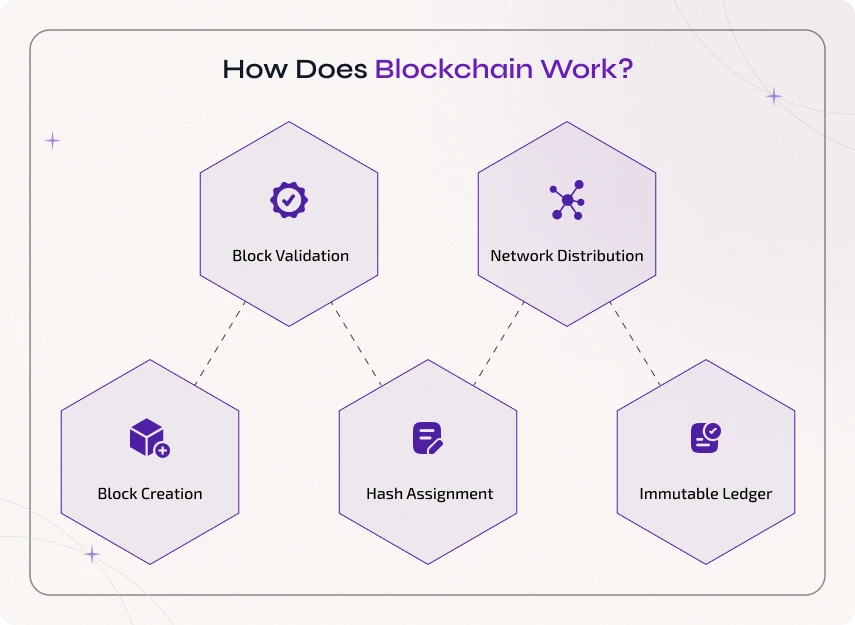

Working with blockchain is nothing like working with spreadsheets or databases.
Blockchains are distributed data-management systems that record every single movement between their users. The complexity of blockchain mechanisms led to their creation. For instance, blockchain contains programs called scripts, where you conduct the tasks to enter, store, and access information easily. Here is our step-by-step process of how blockchain works.
Step 1: Block Creation
A blockchain consists of programs called scripts, which are made up of a chain of “blocks.” Each block holds a set of validated data, including the sender’s and receiver’s information, that are ready for transactions.
Step 2: Block Validation
Once the block is full, the data will run through a cryptographic hash function to check its validity. A consensus mechanism such as Proof of Stake (PoS) or Proof of Work (PoW) can achieve this.
Step 3: Hash Assignment
After analyzing its validation, each block will get a unique identifier called “hash,” which is a cryptographic code. The block will now be added to the blockchain to form a chain sequence.
Step 4: Network Distribution
We will now distribute the blockchain copies across multiple nodes in a network. Thus, in the addition of a new block, the updated blockchain will be shared with others, ensuring everyone has the same copy.
Step 5: Immutable Ledger
Once the block is added to the blockchain, it cannot be altered; rather, it requires altering every subsequent block, which will be noticed by the network. This action will make the blockchain more secure and refractory. Immutability in blockchain is part of creating transparency across other networks, which creates a trustworthy record of all actions.
Benefits of Blockchain Technology
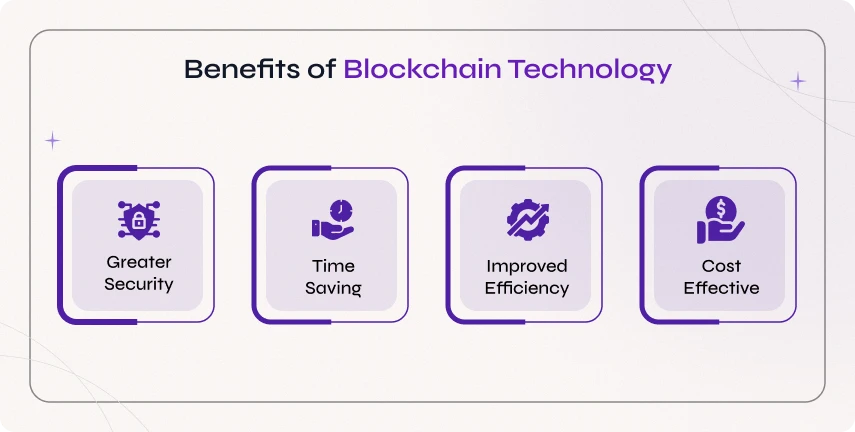

Several benefits of blockchain technology are far beyond the traditional database. Here are a few important features for your reference. Go through them and improvise your thoughts about blockchain technology.
Greater Security:
Blockchain protects sensitive data and information. Its three principles, cryptography, decentralization, and consensus, create highly secure underlying transaction records.Time-Saving:
Blockchain allows you to complete transactions faster and more efficiently with increased time consumption.Improved Efficiency:
Transparency and smart contracts in blockchain make business transactions faster and more efficient.Cost Effective:
It greatly reduces paperwork and errors, which means it eliminates the third parties or middlemen that significantly reduce the transaction costs.Types of Blockchains
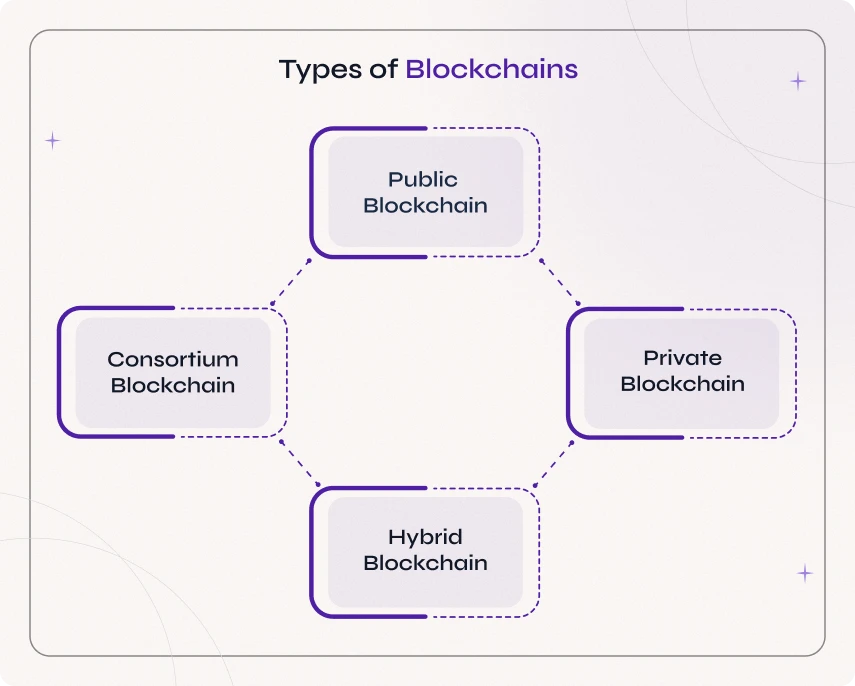

As blockchain technology evolves in this era, there come new variations and ways to build a proper network. Here come the most important and the four main types of blockchain.
1. Public Blockchain
Public blockchains are permissionless and completely decentralized. It doesn't require any access or permission to enter the blockchain network and is highly decentralized, with no single person controlling it. Thus, there is no authentication for a user or an organization to control the ledger, and the user remains anonymous.
2. Private Blockchain
The private blockchains, also known as the permissioned blockchains, cannot be accessed directly without the approval for access. In simple terms, a single organization controls the authority to allow people to access the blockchain networks.
Developing a private blockchain enhances privacy and control over the data to create strict access controls for other applicants. Moreover, it creates an additional restriction on access to an encrypted record-keeping ledger that contains sensitive information.
3. Hybrid Blockchain
A combination of both public and private blockchains is the hybrid blockchain. It is set up by a single organization and consists of only one public authority under a single private system, which provides access to control over sensitive content.
4. Consortium Blockchain
The consortium blockchain, or federated blockchain, is a permissioned network that has similarities to a hybrid blockchain. A consortium blockchain allows multiple users and grants them the authority to edit or cancel the transactions. Moreover, a consortium blockchain is apt for business consultancies where people can access networks with a higher rate of efficiency and privacy.
Common Use Cases of Blockchain
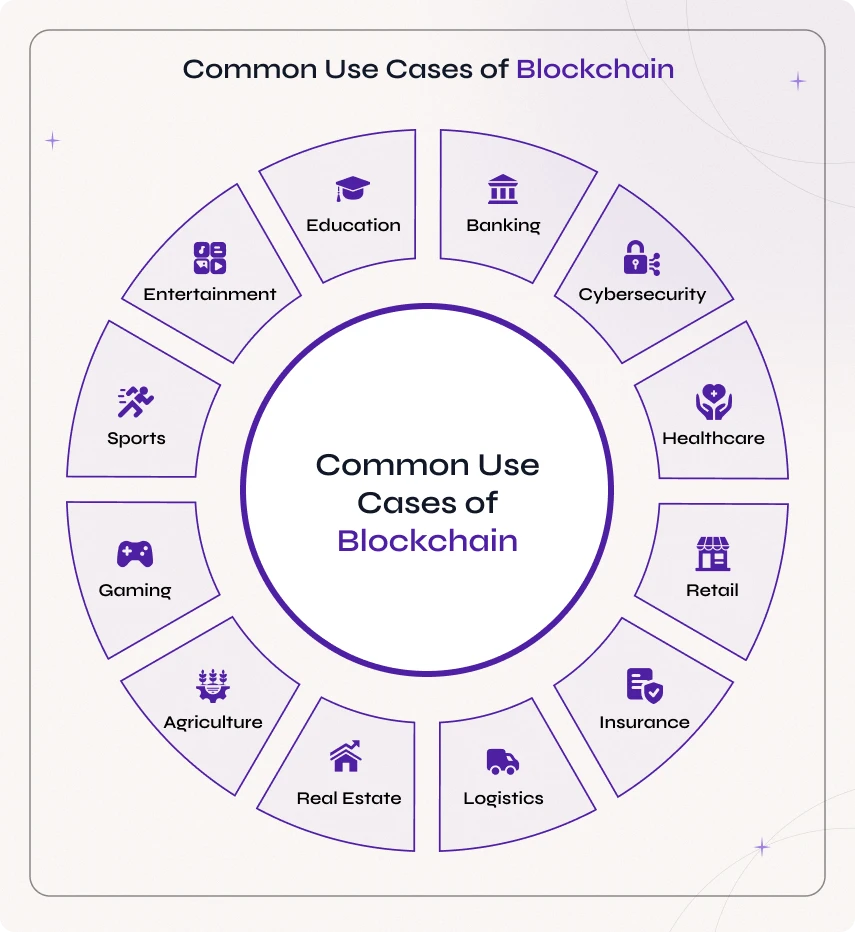

As of now, blockchain continues to exist across various industries, and here are some of the real-world applications where it sustains its growth.
Banking
Blockchain plays a major role in banking by replacing the old processes and paperwork. This system protects against fraud in banking and provides a built-in monitor for money laundering, transactions, and more. Banks can also benefit from faster cross-border transactions at reduced cost and high security by adopting this concept.
Cybersecurity
Blockchain technology produces a decentralized structure of data with inherent security qualities. It paves a high demand to cope with and creates a barrier between the fraud and unauthorized users via cryptographic coding. Together with its improvised privacy, the data recorded in a blockchain cannot be altered or edited, ensuring data integrity.
Healthcare
The healthcare industry majorly uses blockchain technology to securely store patients’ medical records. This technique paves a secure way of sharing medical reports between the patients, healthcare providers, and researchers.
Retail
Blockchain offers transformative benefits for the retail industry by enhancing security, transparency, traceability, and operational efficiency. This technology allows retailers to track products and acts as a perfect barrier between the customer and the product.
Insurance
Insurance companies or providers often use blockchain technology to enhance transparency and streamline processes. However, blockchain’s faster and more trustworthy data exchanges lead to faster claims processing and reduced risks.
Logistics
Blockchain in logistics serves as a tracking tool in monitoring and tracing the movement of goods throughout the entire supply chain. It enhances shipping visibility with more traceable records and removes unnecessary middleman, thus building trust and reducing cost.
Real Estate
Blockchain in real estate doesn't need intermediaries. On the Ethereum blockchain, the real estate company facilitates secure data sharing, streamlining the rental collections and payments to the property owners.
Agriculture
Blockchains are traceable, ensuring farmers directly connect with buyers and sellers, eliminating traditional intermediaries, and reducing transaction costs. It also acts as a digital ledger, which records every piece of transaction and information related to a particular product's journey.
Gaming
In gaming, blockchain allows players to own and play in-game assets, enabling a decentralized, transparent, and secure gaming world for them. Unlike traditional gaming, blockchain gaming focuses on ownership and decentralization, which promises an interactive gaming future.
Sports
Blockchain sports uses blockchain to entitle athletes, enhance fan engagement, and create digital assets. Additionally, it creates real-time sports betting with provably equitable results and enables direct fan funding through tokenization.
Entertainment
Blockchain technology transfigures the entertainment industry by permitting safe transactions and efficient management of royalty payments, digital assets, and fan engagements through tokenization and NFTs. It can be used to tokenize artistic works such as music, art, and films. In the end, every work can be transformed into a digital token that recognizes ownership.
Education
Here, blockchain helps to manage and save students' records, certificates, awards, academic identity, and more through a tamper-proof, decentralized system. This blockchain adoption in managing and monitoring students’ records can create an effective education system.
The Future of Blockchain Technology
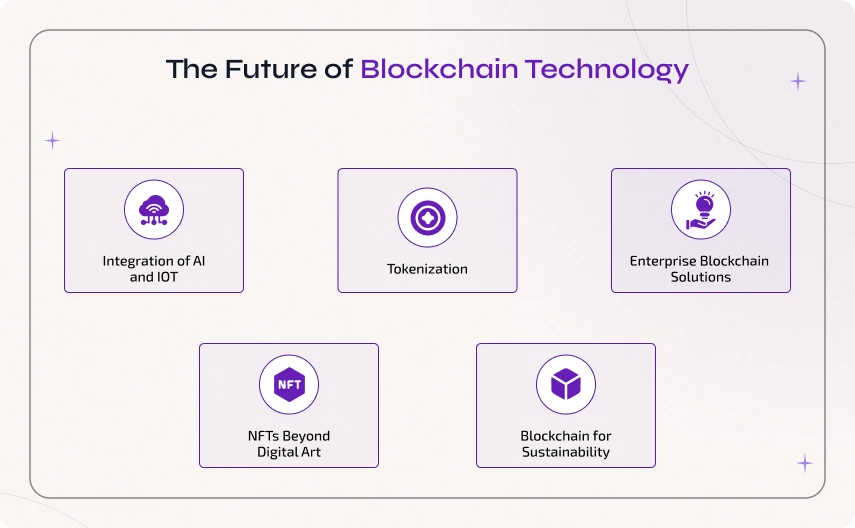

Are you uncertain about the future of blockchain technology—whether it will become mainstream or remain a niche innovation? Continuing its way, blockchain technology evolves to reshape multiple industries globally beyond cryptocurrency. Nowadays, the demand for blockchain proliferates as businesses seek decentralized solutions for transparency, automation, and security.
The future of blockchain is to become the backbone of a decentralized, efficient, scalable, and secure world, which will profit from a competitive edge in the digital ecosystem. Moreover, some of the key trends and predictions where blockchain can be sustained are as follows.
Integration of AI and IoT
In various applications, blockchain technology combines with AI and IoT to offer enhanced security, efficiency, and transparency. It is specifically vital in areas like healthcare, supply chain management, smart cities, and AI’s analytical features
Tokenization
Blockchain technology in tokenization allows a secure and transparent manner of representation of real-world assets as digital tokens. It acts as a barrier to recording all transactions and ownership changes for the tokens.
Enterprise Blockchain Solutions
Business enterprises can increase transparency and provide accessibility to capital markets globally and reduce management costs by digitizing assets on the blockchain networks. It uses a decentralized, immutable ledger to record transactions securely through distributed ledger technology (DLT) and smart contracts. Enterprise blockchain acceptance is predicted to grow significantly in industries like logistics, finance, and healthcare.
Blockchain for Sustainability
Blockchain can improve transparency and accountability in sustainable practices by providing a decentralized ledger of data. Multiple solutions, including carbon credit trading, have led blockchain to achieve more sustainable and eco-friendly development. This enhances the technology's viability for global adoption.
NFTs Beyond Digital Art
Blockchain transactions take place on NFT marketplaces by reducing the obstacles of self-promotion. It acts as a barrier in securing, decentralizing, and recording all NFT transactions and ownership details.
Conclusion
As a result, blockchain technology holds immense potential and promises to bring significant advancements across various fields in the future. By exploring and implementing blockchain, it is finally establishing a clear identity, largely due to the rise of cryptocurrencies like Bitcoin. Here, we can expect to see future developments in blockchain technology that will enhance the usability, security, and scalability of digital assets and cryptocurrencies.
We provide end-to-end blockchain development services across leading networks like Cordano Blockchain Development, Ripple Blockchain Development, Ethereum Layer2 Development, Blockchain Consulting, Enterprise Blockchain Development, Ton Blockchain Development, PEAQ Blockchain development, Bitcoin Layer2 Development, Sui Blockchain Development, XRP Blockchain Development and more to help your busines innovate and develop—Contact BlockchainX.





